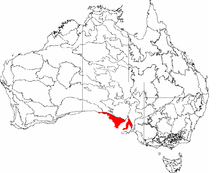Eyre Yorke Block

The Eyre Yorke Block is an interim Australian bioregion and a World Wildlife Fund ecoregion covering the Eyre and Yorke Peninsulas around the Spencer Gulf on the coast of South Australia.[1][2][3]
Location and description
These peninsulas consist of hilly country originally covered in eucalyptus woodland. However this is good soil for farming and the woodland has mostly been cleared for agriculture now. This coast has a temperate climate with a wet winter (300mm to 600mm of rainfall per year).
Flora
The original vegetation of these low hills was woodland of short trees with a shrubby undergrowth. The original woodland consisted mainly of a tea tree Melaleuca lanceolata and mallee box (Eucalyptus porosa), a mallee eucalyptus. The flora of the two peninsulas does differ with that of the Eyre Peninsula having similarities with areas further west as well as number of endemic species, while the Yorke Peninsula has plants typical of areas to the east.
Fauna
Mammals of the region include the eastern grey kangaroo and the southern hairy-nosed wombat, although many more (such as the tammar wallaby have become extinct on the two peninsulas since they have been cleared for farmland. Birds include the emu.
Threats and preservation
This is a heavily populated region and most of the area has been cleared for farmland resulting in reduced populations and local extinction of much wildlife, especially on Yorke Peninsula. However clearance has mostly ceased now and the northern areas of Eyre Peninsula in particular still have large areas of mallee woodland while the coastal dunes remain mostly unspoilt also. Weeds, fertiliser and herbicide runoff are still threatening habitats. Protected areas include Innes National Park on Yorke Peninsula.
References
- ↑ Environment Australia. "Revision of the Interim Biogeographic Regionalisation for Australia (IBRA) and Development of Version 5.1 - Summary Report". Department of the Environment and Water Resources, Australian Government. Archived from the original on 2006-09-05. Retrieved 2007-01-31.
- ↑ IBRA Version 6.1 Archived September 8, 2006, at the Wayback Machine. data
- ↑ "Eyre and York mallee". Terrestrial Ecoregions. World Wildlife Fund. Retrieved 24 July 2012.
Further reading
- Thackway, R and I D Cresswell (1995) An interim biogeographic regionalisation for Australia : a framework for setting priorities in the National Reserves System Cooperative Program Version 4.0 Canberra : Australian Nature Conservation Agency, Reserve Systems Unit, 1995. ISBN 0-642-21371-2